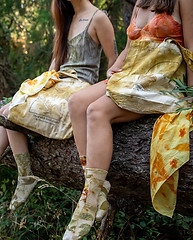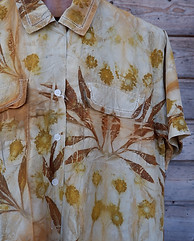Wear Tinctorium
Dyed with seasonal, local plants.
Wear Tinctorium pieces are dyed with local, seasonally abundant plants - exclusively what I can grow regeneratively or forage responsibly. By following a seasonal logic, every piece becomes a reflection of the natural surroundings, allowing you to wear your environment. All pieces have a tag detailing the plants used to create the pattern, and I invite you to learn more about those plants in the journal.
One-of-a-kind wearable art designed to open your eyes to the plants you walk by every day.
Fashion is a notoriously toxic and polluting industry. Even if you don’t follow the trends, we all get dressed every day. Since we spend most of our lives in contact with fabric,
what we wear matters - both to our skin and the ecosystems around us.
From the plants and fabrics used to the dyeing process, Wear Tinctorium pieces offer a regenerative alternative.
Shop in Person

Upcoming Markets
2/11: Mercado Crafts & Design, Jardim da Estrela (Lx)
22&23/11: Mercado das Cores , Mercado de Santa Clara (Lx)
6-8/12: Mercado Crafts & Design, Jardim da Estrela (Lx)
13/12 - EcoMercado, Caldas da Raina
14/12 - Criadores.pt, 8 Marvila (Lx)

Visit the showroom in São Domingos de Rana - about 25 minutes Lisbon, Cascais, and Sintra and 10 minutes from Carcavelos. The showroom is open during Open Studio days or by appointment.
No walk-ins, please.
The Dyeing Process
The technical foundation of my work is rooted in ancestral dye practices developed across the world, dating back 5,000 years. Pre-treatment steps like scouring and mordanting are crucial stages that ensure success. The passage of time hasn’t changed these fundamentals, but now we know much better what materials are non-toxic and safe to dispose in the garden. A perfect example of how just because something is natural does not make it sustainable.
A truly earth-aligned practice prioritizes how things are done over simply chasing a visual result. A process-based approach requires careful observation of how many factors interact with each other. Beyond the fabric preparation, each micro-decision along the process will influence results (i.e. humidity, pressure when rolling, and time cooked). Each plant carries its own preferences and personality (i.e. season of harvest, sunlight exposure, rainfall, or soil fertility). Each fabric will behave differently (i.e. composition, weave type, thickness, finishings). Chasing a sanitised perfection can mean fighting the technique with unnecessary plastic barriers and wasteful protocols.
Because there is so much at play that cannot be controlled, I prefer an intuitive approach where I can creatively respond to the interactions between fabric - mordants - and plants. My dyeing practice is a dance with the surrounding environment: noticing what’s abundant, what’s invasive, and what’s available. I am a tool for the landscape, becoming a bridge between the invisible potential of color hidding in the plants and its visible expression on fabric.
Curious what it takes to go from plant and fabric to a Wear Tinctorium piece? I’ve detailed the full process from start to finsih below:

Angelique, Aruba & PT
“Sharing the exciting news that my mom LOVED this set... she was blown away by the colors, fabric, and patterns!
I told her how you make it and she was soo soo impressed by your art!!"
Delphine, UK
"I wore your shirt today! Bought on the market from you in Lisbon back in March. It gets so many compliments!! I love it thank you."
Rafaela, PT
“Ainda nem acredito que tenho um vestido tão bonito. Até nem sei expressar o quão feliz estou com este vestido.”















